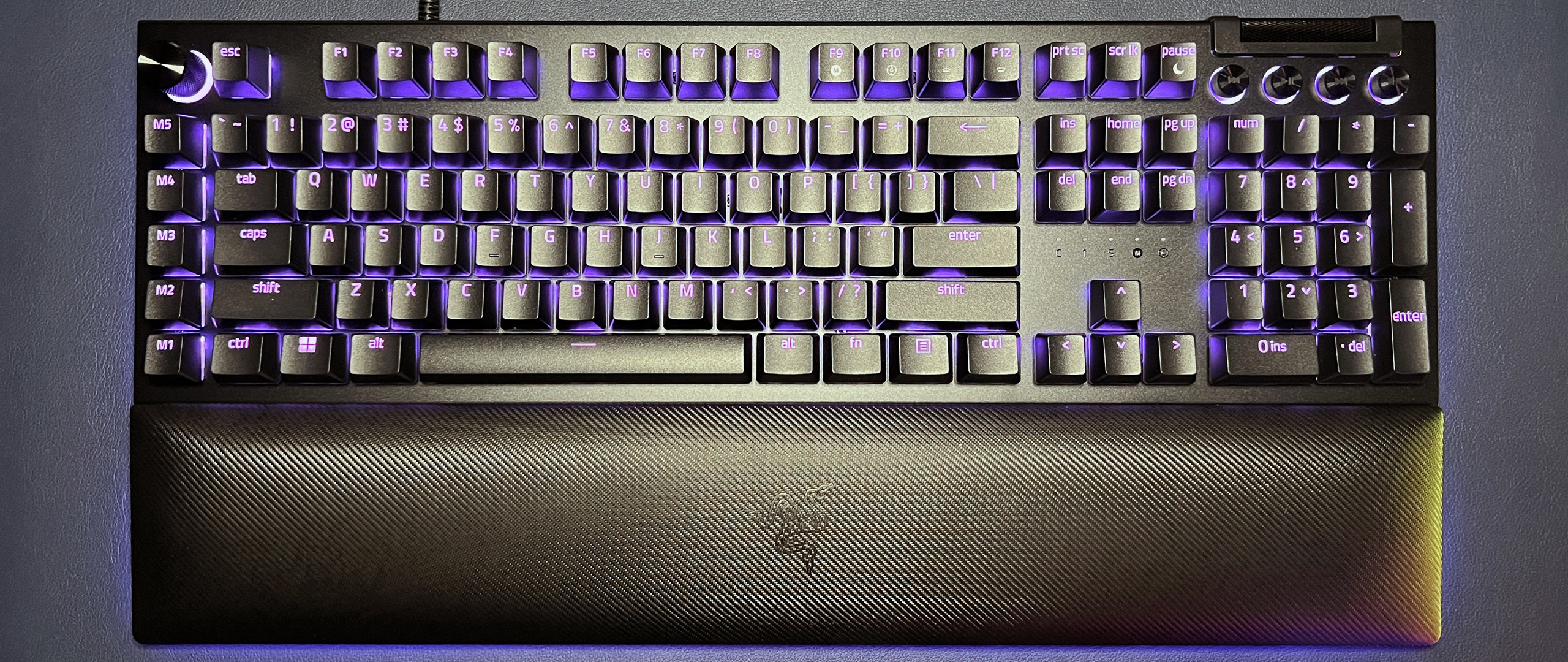Best Gaming Keyboards 2025: Full-size, TKL, Mini, and More
The best gaming keyboards we've tested for grinding, shooting, exploring, and, well, typing.

Your keyboard is your primary connection to your PC — a new keyboard will deliver a more immediately-noticeable difference than just about any other upgrade. (And it's a lot cheaper than a new GPU.)
Finding the right keyboard is critical for anyone, and it's even more critical for gamers: you need a gaming keyboard that's not only comfortable and easy to type on, but that also delivers the perfect amount of tactile feedback, with zero latency, for speed and accuracy. It has to be the right size — big enough for your macros and shortcuts, but not so big it impedes your mouse movement.
Your keyboard will be your main sidekick as you navigate complicated battle maps and vast open worlds, so you don't want to make this choice lightly. We've tested gaming keyboards in every size, color, and style, and these are the best we've found. This list includes both wired and wireless keyboards in every price range — if you've narrowed down your criteria, check out our more specific lists of the best wireless gaming keyboards and the best budget mechanical keyboards.
Best Gaming Keyboard Overall
Specifications
Reasons to buy
Reasons to avoid
I rotate keyboards pretty frequently, but there's one I keep coming back to: the Asus ROG Strix Scope II 96 Wireless. The ROG Strix Scope II 96 Wireless is an excellent option for gaming, typing, and everything in between — it's well-built and it feels fantastic, it has plenty of keys (including a 10-key numberpad) but it won't take up too much desk space, and it's wireless with tri-mode connectivity and a whopping 1,500 hours of battery life (over 2.4GHz wireless, with the lighting turned off). Of the mainstream gaming peripherals makers, Asus is the only company that has managed to really bring enthusiast-style upgrades into what is still, first and foremost, a gaming keyboard.
The ROG Strix Scope II 96 Wireless has a 96-percent layout — which is like a full-size layout, minus a handful of keys (and squashed together). While the layout does take some getting used to if you're coming from a full-size keyboard, once you get the hang of it it's the best of both worlds: a practically full-size keyboard with a 10-key numberpad that's more compact than some TKLs. The Strix Scope II 96 Wireless measures 14.84 x 5.16 x 1.57 inches (377 x 131 x 40 mm), which makes it smaller than our favorite TKL (the Lemokey L3, which measures 15.78 x 5.39 x 1.69 inches / 401 x 137 x 43 mm). It does come with an optional magnetic wrist rest, but it's low enough in front that I never felt a wrist rest was necessary.





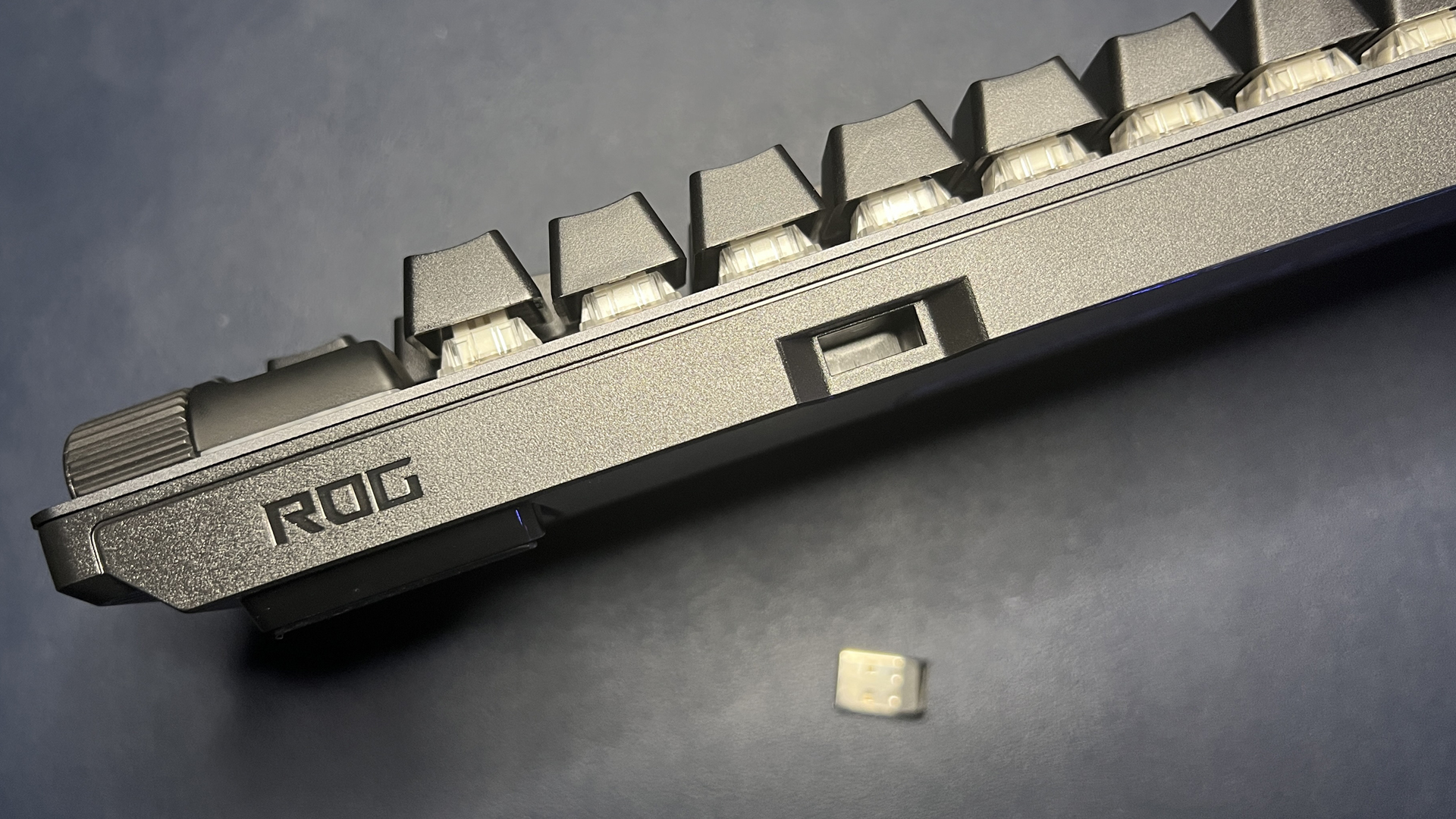

It's also sturdily-built — it weighs 2.23 pounds (1012g), which is heavy enough that you'll appreciate the heft, but not so heavy that you couldn't reasonably travel with it. The keyboard has an aluminum alloy top plate and double-shot PBT keycaps (a nice touch — most mainstream companies still ship their flagship keyboards with ABS keycaps) and a plastic chassis that ensures an uninterrupted, low-latency wireless connection. While the 96-percent layout doesn't leave much room for extra shortcut/macro keys, Asus did manage to stuff a multi-function key and clickable roller in the upper right corner, which lets you control volume, media, and lighting, and also has a customizable mode that can be programmed in Armoury Crate.
The ROG Strix Scope II 96 Wireless comes with Asus's ROG NX Snow (linear) or Storm (tactile) mechanical switches preinstalled — I tested the linear RX Snow switches, which are pre-lubed and have an actuation force of 45g and an actuation point of 1.8mm. I'm not the biggest fan of linear switches in general, but the NX Snow switches did offer a silent, smooth, stable "refined" feel — and even I couldn't find too much to complain about. Plus, the keyboard's PCB is hot-swappable, so you can fully customize your typing experience by swapping in any mechanical switches (it supports both 3- and 5-pin switches) you like.
A keyboard doesn't have to be wireless to grab the top spot on our list, but this one is — with both low-latency 2.4GHz wireless and Bluetooth connectivity, as well as wired (via USB-C). And this keyboard's battery life is impressive — to say the least. Asus rates the ROG Strix Scope II 96 Wireless' battery life at 1,500 hours over 2.4GHz wireless — with the lighting turned off, of course — which is, well... plenty.
Read: Asus ROG Strix Scope II 96 Wireless Review
Best Full-Size Gaming Keyboard
Specifications
Reasons to buy
Reasons to avoid
If you've got the desk space, a full-size gaming keyboard is absolutely worth it. The Razer BlackWidow V4 Pro is Razer's premium full-size wired gaming keyboard and it's completely decked out with eight dedicated macro keys/buttons (five keys, three side buttons), a tactile, multi-function "Command Dial," and bright, immersive backlighting and underglow that extends to the included wrist rest.
The BlackWidow V4 Pro is on the larger side — and it comes with a detachable wrist rest, so the full setup takes up even more space. It measures 18.25 x 6 x 1 inches (464 x 152 x 25 mm), not including the keycaps, and the wrist rest is about 3.25 inches (82.6 mm) deep, making the full dimensions 18.25 x 9.25 inches (464 x 235 mm). The wrist rest is a plush, padded leatherette that attaches magnetically to the keyboard and extends the keyboard's underglow via a 5-pin connection point. The keyboard's underglow has 18 programmable zones without the wrist rest attached, and the wrist rest adds another 20 zones for a fully immersive, seamless blend of color (the keyboard also has per-key RGB).


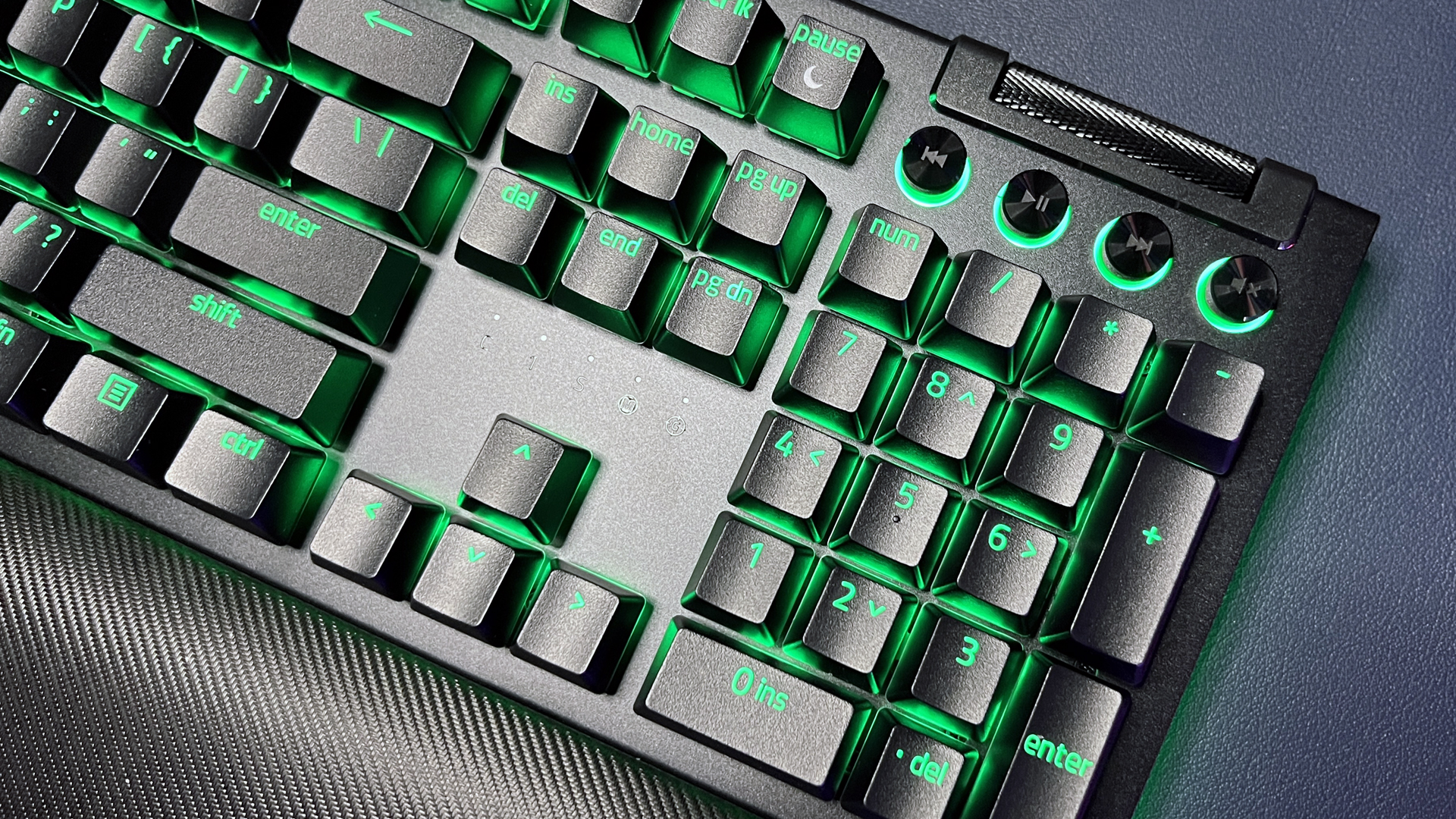
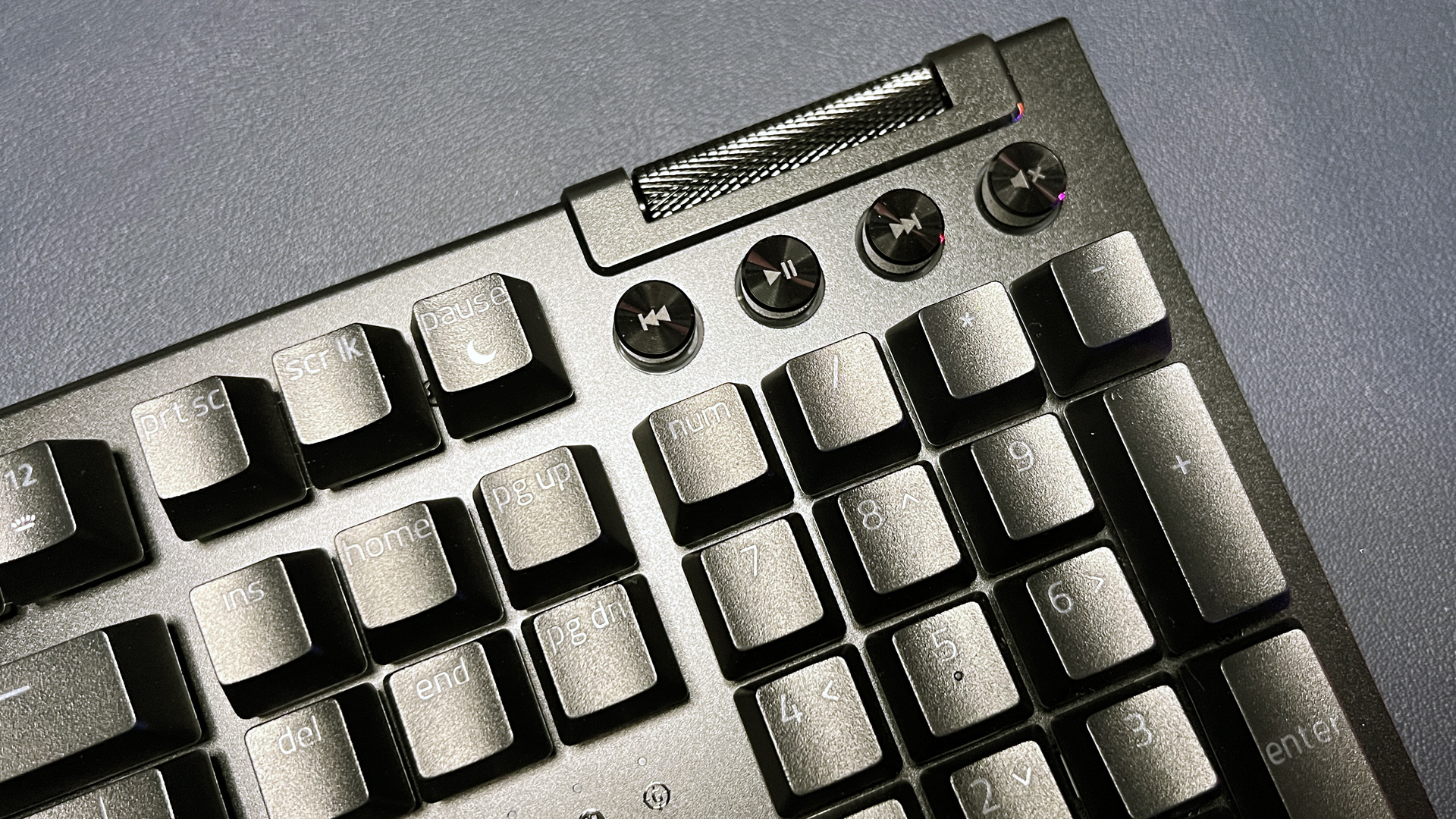


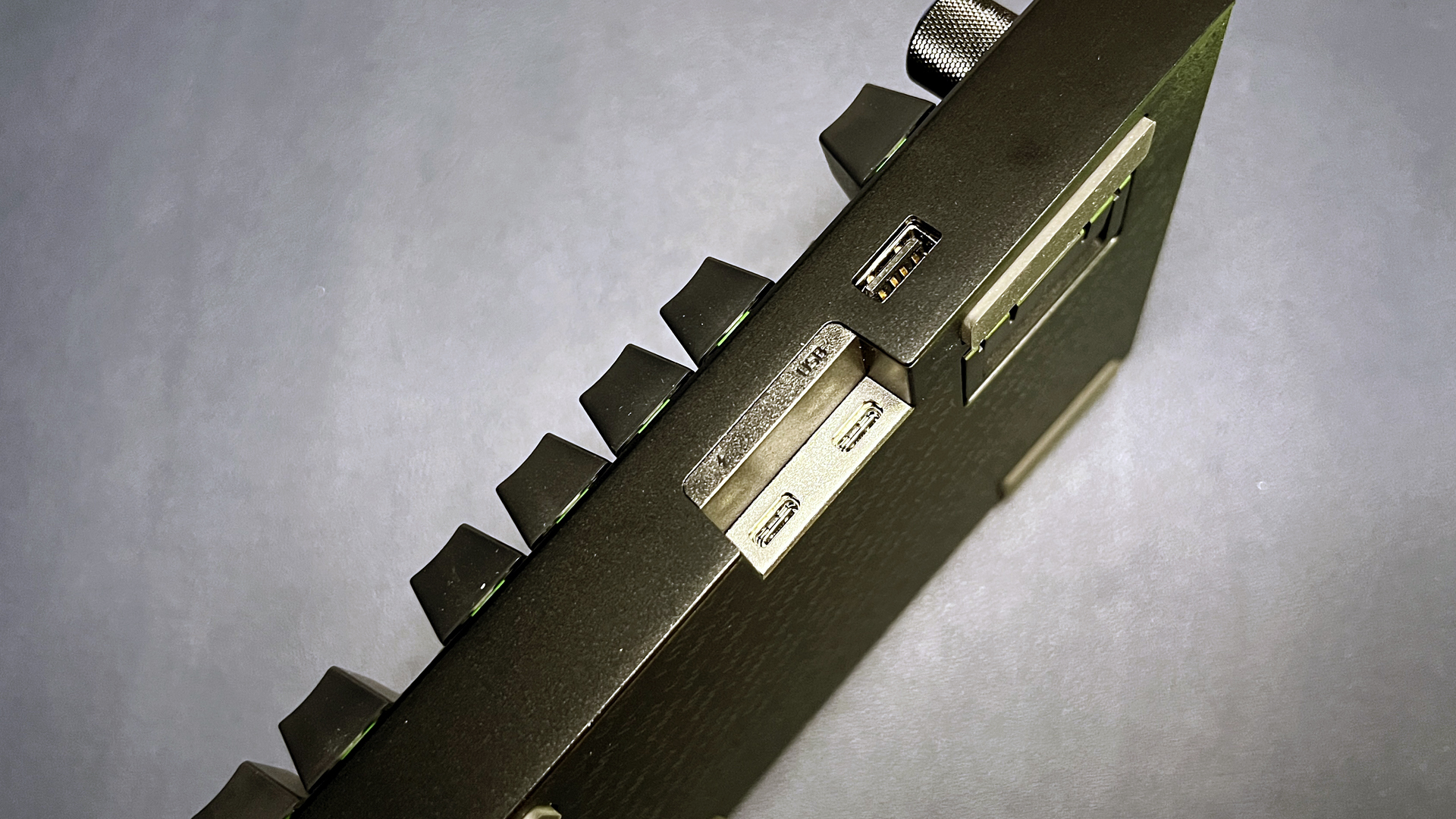
The BlackWidow V4 Pro features an aluminum alloy top plate over a plastic chassis and ABS keycaps, with machined metal media keys (four in the upper right corner — previous track, play/pause, next track, mute) and a textured volume roller. On the left side of the keyboard there are five dedicated macro keys (labeled M1 - M5), as well as three dedicated macro buttons along the side of the chassis. Above the macro keys you'll find a programmable rotary knob — the "Command Dial," which is customizable through Razer Synapse and has a dedicated backlight to help you identify different modes. If you're looking for a keyboard with a lot of extra functionality, this is it — all of the BlackWidow V4 Pro's keys are programmable, and you can program up to 100 custom modes on the Command Dial (it ships with four preset modes activated: keyboard brightness, windows zoom, switch applications, and track jogging.
This keyboard is not hot-swappable, and it comes with your choice of either Razer Green (clicky) or Razer Yellow (linear) mechanical switches. Razer's Green clicky switches are a little heavier than other clicky switches, with 50g actuation force and an actuation point of 1.9mm, but I've always been a pretty big fan of how loud and obnoxious they are. The BlackWidow V4 Pro launched before Razer started experimenting with more enthusiast-style sound-dampening like you'll see in the Razer BlackWidow V4 75%, so it's definitely a bit pingy when you're typing — but maybe that only adds to the overall obnoxiously loud, clicky charm.
It's fantastic for gaming, however, with fully programmable keys (including the macro keys/buttons, media keys, volume roller, and Command Dial) and an extra layer via Razer HyperShift, up to five onboard profiles, full N-key rollover, and up to an 8,000 Hz polling rate. It's a wired keyboard, so you won't have to worry about the per-key lighting and underglow sapping battery life, and it features a USB passthrough port (which is somewhat of a rarity, even on full-size keyboards, these days).
There are, of course, some drawbacks to the BlackWidow V4 Pro — namely, its $230 price tag. It's hard to find a fully decked-out full-size gaming keyboard with all the features of the BlackWidow V4 Pro, but not everyone needs so many extra keys, buttons, dials, and lights. The $100 Corsair K70 Max RGB has a customizable rotary knob, while the $140 NZXT Function 2 has dedicated left-side media keys and a volume roller (none of these are programmable, however). If you're just looking for a full-size keyboard with no frills, the $110 HyperX Alloy Origins is a solid option that frequently goes on sale.
Read: Razer BlackWidow V4 Pro Review
Best TKL Gaming Keyboard
Specifications
Reasons to buy
Reasons to avoid
The Lemokey L3 is the first gaming keyboard from Keychron's spin-off brand, and it's a pretty impressive offering — especially if you're looking for a gaming keyboard that you'll also love typing on. The L3 is a wireless mechanical gasket mount keyboard with a hot-swappable PCB and a compact (but not too compact) TKL layout. It comes in both fully-assembled ($214) and barebone ($194) versions in three color variations (carbon black, navy blue, or space silver). The fully-assembled version comes with your choice of Gateron Jupiter Red (linear), Gateron Jupiter Brown (tactile), or Gateron Jupiter Banana (tactile) switches.
The L3 is definitely an enthusiast-focused gaming keyboard — it sports a very solid build with a CNC-machined 6063 aluminum chassis that weighs a hefty 4.36 pounds (1976g). This keyboard is on the larger side for a TKL, measuring 15.78 x 5.39 x 1.69 inches (401 x 137 x 43 mm). This layout gives you plenty of room between key clusters, as well as space for an extra row of macro keys and a rotary knob on the left side. All keys and the knob are programmable using the open-source firmware/software package QMK/VIA.



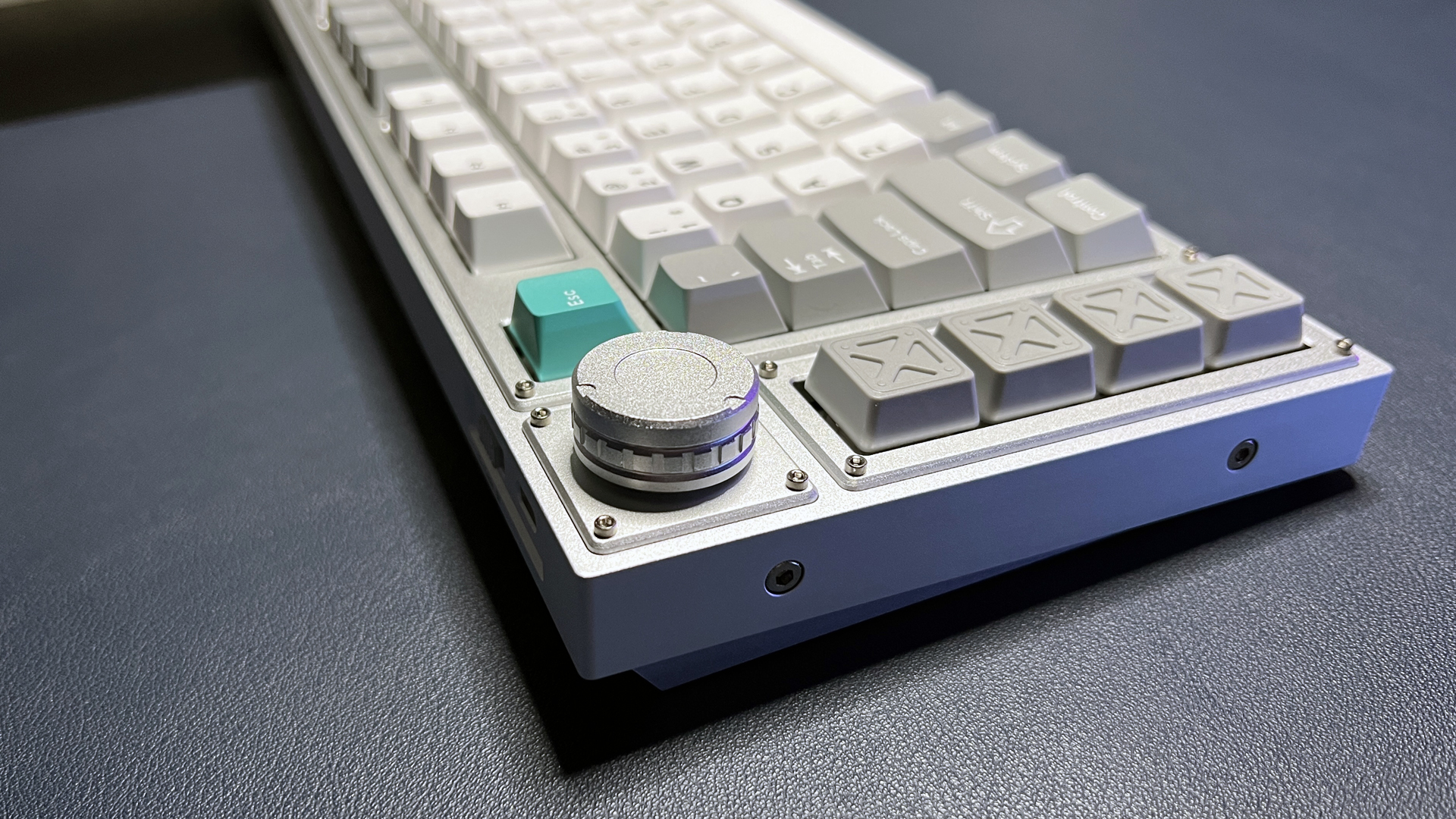



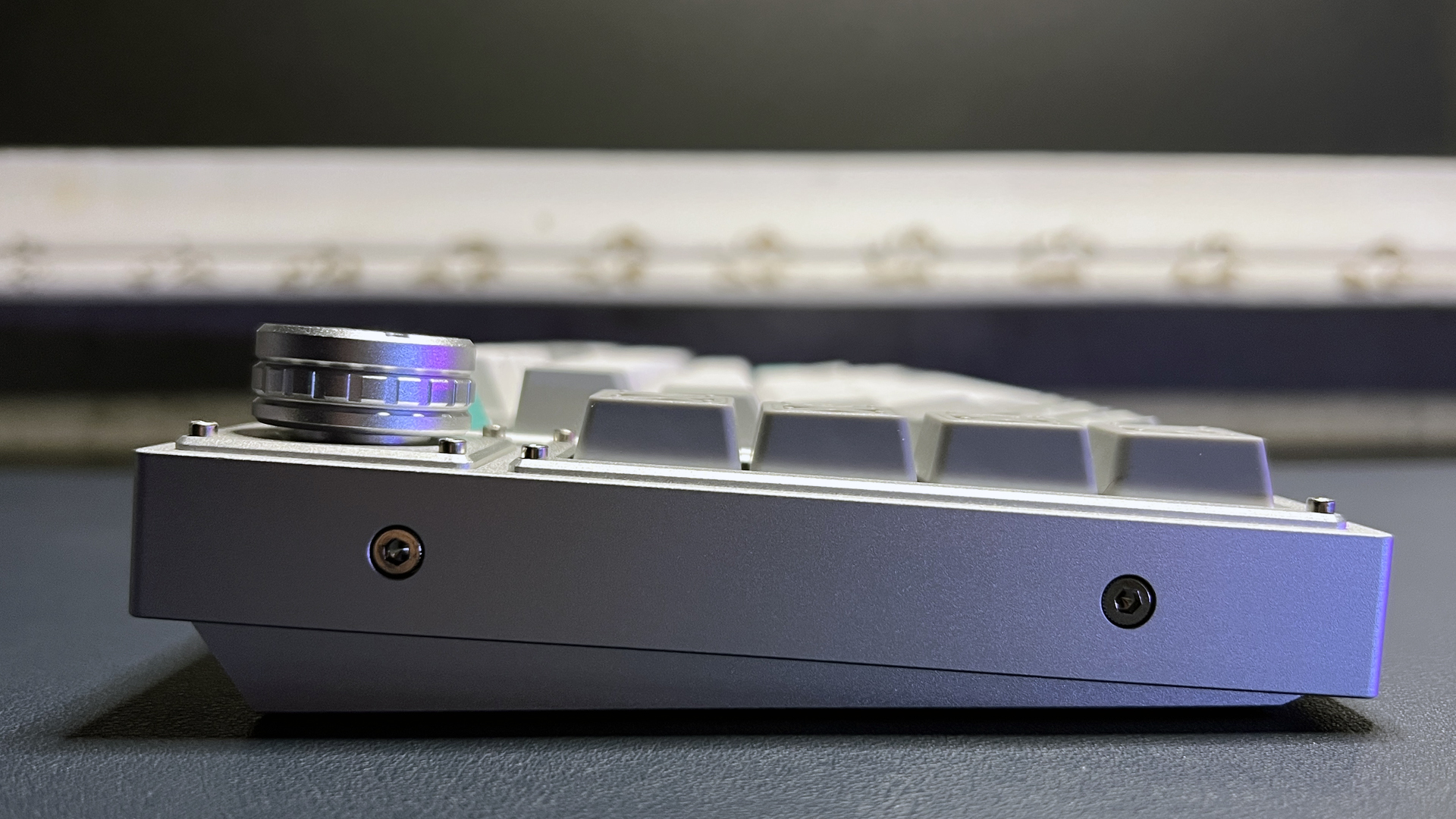
Typing on the L3 is fantastic, whether you're using the included Keychron-exclusive Gateron Jupiter switches or your own switches. The keyboard has a double gasket mount design with two layers of sound-dampening foam in the case, and sounds much better than just about any mainstream gaming keyboard. It also comes with Keychron's Cherry-profile keycaps in double-shot PBT, which have a lower profile than standard OEM keycaps. The L3 offers three forms of connectivity: low-latency 2.4GHz wireless, Bluetooth 5.1, and wired (USB-C). Its 2.4GHz connection has a gaming-standard 1,000 Hz polling rate and gets around 200 hours of battery life (with the lighting turned off).
The main drawback of the Lemokey L3 is that it's not quite as gamer-y as other gaming keyboards. If you're looking for a keyboard that will blend into your battle station, the L3's chunky aluminum chassis and generically-customizable lighting isn't going to fit quite as well as something like SteelSeries' Apex Pro TKL Wireless or Razer's Huntsman V3 Pro TKL. The L3 is also larger than most TKL keyboards — if you're looking to recoup desk space, you may want to go with something even smaller than a TKL, such as the 75-percent Asus ROG Azoth.
Read: Lemokey L3 Review
Best Mini Gaming Keyboard
Specifications
Reasons to buy
Reasons to avoid
They're not for everyone, but if you don't need all the extra keys on full-size and TKL layouts, an ultra-compact 65- or 60-percent keyboard might be right for you. Mini keyboards drop everything but the absolute necessities: a 65-percent layout has no numberpad, navigation cluster, or function row; a 60-percent layout also drops the arrow keys. Fewer keys means a much smaller footprint, perfect for gamers who want to angle their keyboards, have a smaller desk, or need something to travel with. But fewer keys also means you'll need pretty robust customization options, which is why the SteelSeries Apex Pro Mini Wireless is our favorite ultra-compact gaming keyboard.
The Apex Pro Mini Wireless is a sleek, sturdily-built 60-percent keyboard featuring the brand's OmniPoint 2.0 HyperMagnetic switches. If you're wondering: at launch these were called OmniPoint 2.0 optical switches and SteelSeries rebranded them as HyperMagnetic to tag onto the trend of magnetic switches — they're the same switches, and, like other magnetic switches, feature adjustable actuation points, but SteelSeries did push out a firmware update that unlocked a wider actuation range and added a Rapid Trigger option. The Apex Pro Mini Wireless comes with a slew of preset secondary keybinds, which are conveniently printed on the sides of the keycaps and are relatively intuitive. And if you don't find them to be particularly intuitive, you can also remap almost every key (both primary and secondary keybinds). You can also set each key's actuation point and RGB lighting individually (if you want).





The Apex Pro Mini Wireless features an aluminum alloy top plate and double-shot PBT keycaps, and is otherwise pretty straightforward. It measures 11.53 x 4.02 x 1.59 inches (293 x 103 x 40.3mm) which is about the same size as other 60-percent keyboards (such as the Razer Huntsman Mini). It weighs 1.2 pounds (543g), which is heavy enough to feel premium, but lightweight enough to be travel-friendly. The keyboard offers both 2.4GHz wireless and Bluetooth 5.0 connectivity (as well as wired via USB-C), and gets around 30 hours of battery life over its low-latency 2.4GHz wireless connection.
SteelSeries also offers a wired version, which is identical minus the battery; the Apex Pro Mini Wireless currently costs $190 (MSRP $240), while the wired version is quite a bit cheaper at $140 (MSRP $180). The company also recently dropped the limited-edition Apex Pro Mini Prebuilt: White Gold Edition (wired), which features a white aluminum chassis, white double-shot PBT keycaps, and a brass top plate. This edition is built more like a keyboard enthusiast's keyboard, with a hefty brass weight plate that added an extra pound and half to the build for a total weight of 2.75 pounds (1,242g) and no height adjustment. It's otherwise no different from the regular Apex Pro Mini, however — same actuation-adjustable switches, gamer-friendly customization options, and per-key RGB lighting.
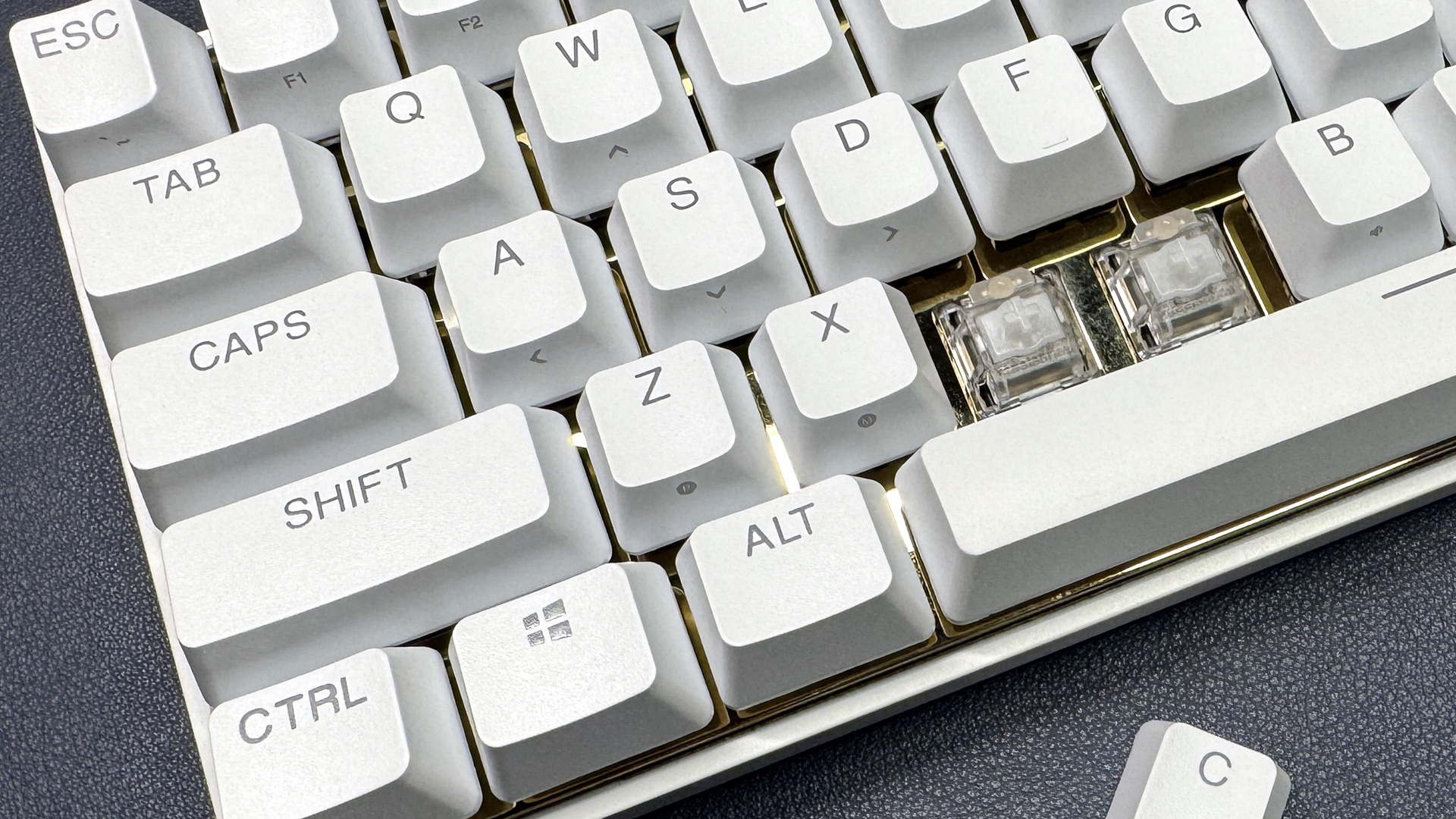
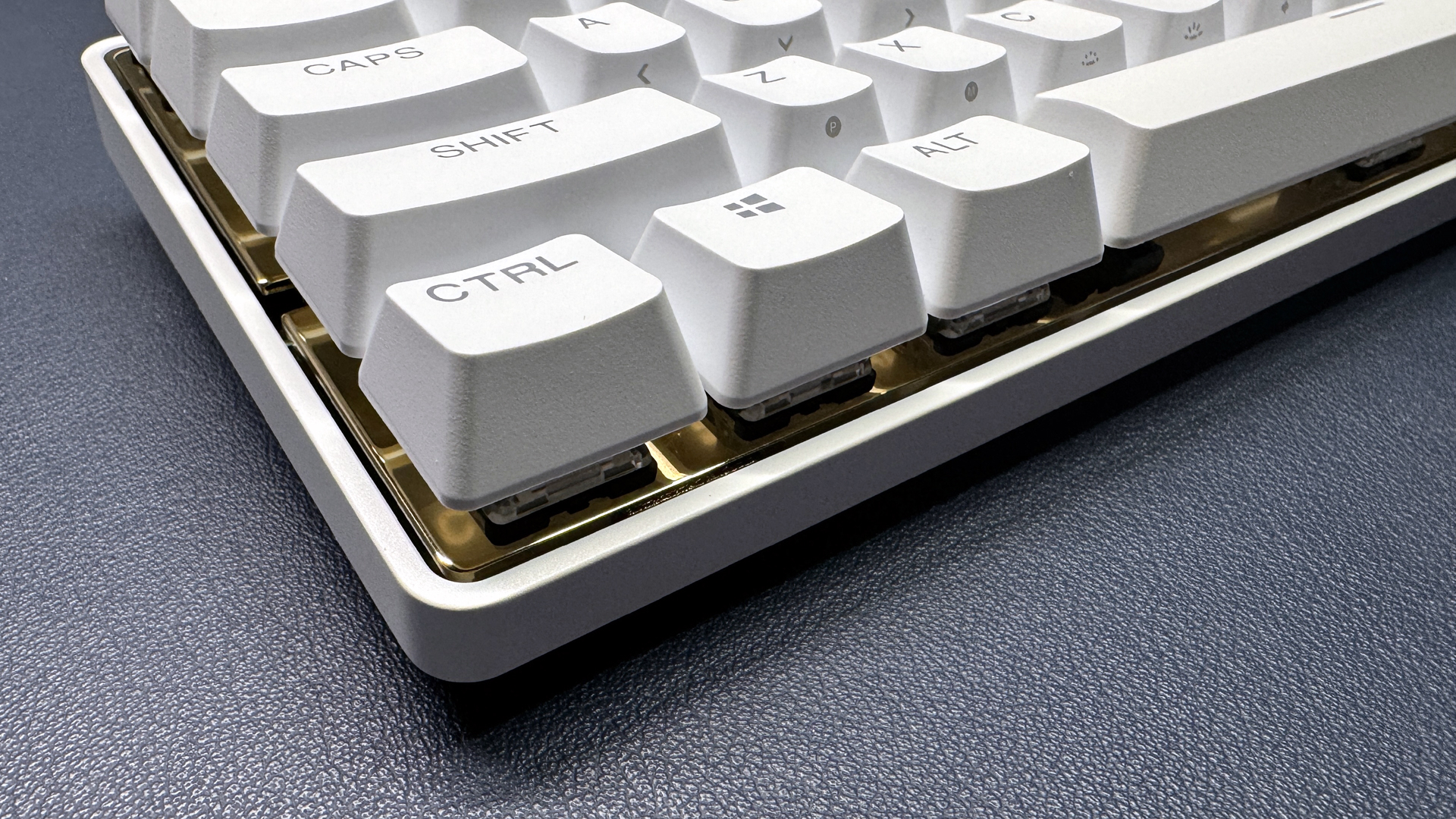


I'm not the biggest fan of peripheral software, but customization is so critical to mini keyboards that this may be the one place where overly-ambitious, bloated gaming peripheral software is actually... not the worst option. SteelSeries' GG software has its issues, but it lets you customize the Apex Pro Mini Wireless to suit your typing/playstyle by remapping keys and adjusting actuation (actuation point, dual actuation, and Rapid Trigger), and you can store up to five profiles on the keyboard's hardware.
Read: SteelSeries Apex Pro Mini Review
Best Budget Gaming Keyboard
Specifications
Reasons to buy
Reasons to avoid
Cooler Master's MK770 isn't the cheapest gaming keyboard you can find, but $119 is a fantastic price for everything you get in this keyboard. It's a well-built, wireless, gasket mount mechanical gaming keyboard with a hot-swappable PCB and a 96-percent layout. These specs, you'll notice, are pretty similar to the Asus ROG Strix Scope II 96 Wireless, but the MK770 retails for $60 less.
The MK770 comes in two colorways: 'Space Gray' and 'Macaron,' which is a unique pastel mix of mint green, light pink, and pale yellow. It features a sturdy plastic chassis with one set of flip-out feet for angle adjustment and double-shot PBT keycaps with shine-through legends. It's not quite as sleek as the ROG Strix Scope II 96 Wireless, with a slightly larger, bulkier chassis that measures 15 x 5.5 x 1.5 inches (380.9 x 140.4 x 38.7 mm) but is still pretty economical, space-wise. It weighs around the same amount at 2.3 pounds (1052g).



The MK770 comes with Kailh Box V2 switches in Red (linear), Brown (tactile), or White (clicky). We reviewed it with the White switches, which require 45g to actuate (50g to bottom out), and have an actuation point of 1.8mm with 3.6mm total travel. The keyboard features a gasket mount design, which adds a nice amount of flex for a more comfortable (and better-sounding) typing experience. The keyboard also features a hot-swappable PCB that supports 5-pin switches, so you can easily swap in switches of your choice. Like other 96-percent keyboards, the MK770 has a 10-key number pad but drops some of the navigation cluster — namely, Print Screen, Scroll Lock, Pause, Home, and End — but it does feature a volume knob in the upper right corner.
This keyboard is wireless, with tri-mode connectivity: low-latency 2.4GHz wireless via USB-A dongle (the keyboard even has a handy place to store the dongle, under one of the flip-out feet), Bluetooth (up to 3 devices), and wired via USB-C. It has a 4,000 mAh battery, and while Cooler Master provides no battery life estimates, our reviewer was able to use it for about a week (over 2.4GHz wireless, with the lighting turned off) before recharging. The only real issue we had with this keyboard was the customization aspect — because the software is... not great.
The MK770 uses Cooler Master's universal MasterPlus app, and it's a buggy program from the get-go — slow to boot, laggy, and prone to crashing. You can use it to remap keys, record macros, change a handful of settings, and customize the keyboard's RGB backlighting — though that's also nothing to write home about.
It's nice to see a solid, feature-rich gaming keyboard from a mainstream peripheral company that doesn't cost close to $200. But if $119 is out of your budget, we also love the Akko 3098B/N, which is a wireless 96-percent hot-swappable keyboard that's great for both gaming and typing and can currently be found for $90. You can also find several budget-friendly mechanical keyboards (though these aren't necessarily gaming keyboards) on our list of best budget mechanical keyboards.
Read: Cooler Master MK770 Review
Best Magnetic Switch Gaming Keyboard

Specifications
Reasons to buy
Reasons to avoid
Arbiter Studio's KITSUNE Polar 75 Pro is an impressive wired gaming keyboard with a compact 75-percent layout and Hall Effect magnetic switches. The magnetic switches allow for features such as Rapid Trigger, Snap Tap (SOCD), and have adjustable actuation — all good things for gamers who are interested in ultra-low latency and speed.
It's a well-built, premium-feeling keyboard with a matte anodized aluminum top case over a semi-translucent bottom case and thick dye-sub PBT keycaps. I also really like the aesthetic — it's just a black and white keyboard (black case, white keycaps with printed black legends), but it features the brand's "Kitsune" styling — a fox on the Esc key, kitsune in Japanese (though it's in katakana, which doesn't really make sense as kitsune is a native Japanese word, but I guess... it's stylized), and some other touches that give it a cool, modern vibe without going overboard. The keycaps come in Arbiter's AOP profile, which is lower and more sculpted than the KOP profile.
The Polar 75 Pro comes with Fuji Pro linear magnetic switches as well as a hot-swappable PCB — though it's only compatible with certain other magnetic switches, so it's not quite as versatile as your typical hot-swappable keyboard. It offers an impressive typing experience in both feel and sound, thanks to the two layers of dampening silicone in the case and the keycaps' curvy sculpting. In fact, it's still one of the best-sounding keyboards I've ever used, and the typing experience is so good it's near the top of my list even if we include traditional mechanical switches. The switches feature an adjustable actuation range of 0.1 to 3.8mm (with a sensitivity of 0.1mm), and each key can be set individually in Arbiter's Web App.
Magnetic switches are hot in gaming these days, but most magnetic switch keyboards offer a less-than-impressive typing experience. Arbiter Studio's Polar 75 Pro has one of the best typing experiences you'll find, and it's set up for gamers — though its Web App does lack some of the fancy gaming features you'll find in more developed peripheral apps, such as Synapse and iCue. But if you haven't been inundated into the gaming peripheral software fold (you should avoid it, if you can, in my opinion), the Polar 75 Pro — or the Polar 65 Pro, if you're looking for a nice 65-percent layout — should definitely be on your list.
Read: Arbiter Studio Polar 75 Pro Review
Other Gaming Keyboards We Tested
Asus ROG Azoth X
The latest board in Asus' Azoth lineup has a brand-new aesthetic — it's much more colorful and unique than the original Azoth — and a brand new price tag of $300. That's $50 more than the original and just $200 less than the extreme version. It features a hot-swappable PCB, Asus' second-gen "refined" linear or clicky switches, a gasket-mount design, and five layers of sound-dampening foam, but the typing experience is just okay thanks to a thunky extra-dampened spacebar. It offers tri-mode connectivity and up to 1,600 hours of battery life, plus a web-based Armoury Crate that I have yet to find. For a gaming keyboard, it's good. But not for $300.
Read: Asus ROG Azoth X Review
Glorious GMMK 3 Pro
Glorious' newest GMMK 3 lineup is fancy, and the flagship feature is the brand's custom keyboard builder: the GMMK Boardsmith. The Boardsmith lets you build your own keyboard: wired or wireless; 65-percent, 75-percent, or full-size; MX mechanical or magnetic switches; with a custom case, accents, and keycaps. It's a one-stop shop for those who want a custom-built gaming keyboard, and it's fairly unique in the world of mainstream gaming keyboards. But it's just so... expensive.
The cheapest pre-built (non-customized) GMMK 3 starts at $119 for a wired, 65-percent mechanical keyboard with a plastic case, while the priciest GMMK 3 is $409 for a wireless, full-size magnetic switch keyboard with an aluminum case. If you decide to build your own board, that price can go all the way up to $608, which is pretty crazy for mechanical keyboard from a mainstream gaming company. While the GMMK 3 is very well built and is highly customizable... it's still a mainstream gaming keyboard.
Read: Glorious GMMK 3 Pro Review
Asus ROG Azoth Extreme
The Asus ROG Azoth Extreme is the anticipated "extreme" version of Asus' flagship premium gaming keyboard, the ROG Azoth. The Azoth Extreme takes the already-pretty-extreme Azoth to the next level with a full aluminum alloy chassis, a carbon fiber positioning plate, refined sound dampening and stabilizers, a full-color, customizable, touch-gesture-enabled OLED screen, an adjustable gasket mount, and a wrist rest. But all this doesn't come cheap: the Azoth Extreme is a whopping $500 — twice the price of the already-expensive $250 Azoth.
The Azoth Extreme is a well-built 75-percent mechanical gaming keyboard with a meticulously machined case, per-key RGB backlighting, double-shot PBT keycaps, and Asus' linear or clicky switches. It also has a hot-swappable PCB, a carbon fiber positioning plate, and a gasket mount that can be adjusted via a switch on the back for a softer or firmer typing feel. Out of the box, the Azoth Extreme sounds and feels even better than the original Azoth (which already sounded and felt fantastic).
The Azoth Extreme is definitely... extreme. And it's so well-built that it arguably earns its high price — but that doesn't necessarily mean it's worth buying. The Azoth Extreme is highly customizable, but most of that customizability will likely go unused by the majority of gamers — you're not paying $500 for a keyboard you then have to turn around and customize.
Read: Asus ROG Azoth Extreme Review
Logitech G515 Lightspeed TKL
The new G515 Lightspeed TKL features the same general design as the rest of the GX15 lineup, but with updated switches, access to Logitech's KEYCONTROL, and a budget-friendly price of $140.
The G515 Lightspeed TKL is a wireless mechanical gaming keyboard with Logitech's low-profile GL switches (linear or tactile), which now have a POM cross-style stem for reduced wobble and a better typing experience. It sports a slim, all-plastic build with premium-feeling double-shot PBT keycaps and bright per-key RGB backlighting. While it's not quite as satisfying to type on as a similarly-equipped full-height gaming keyboard, the G515 Lightspeed TKL offers a very pleasant typing experience with consistent tactile feedback and solid (if not perfect) gaming performance.
It features both 2.4GHz wireless and Bluetooth connectivity and gets 36 hours of battery life over 2.4GHz wireless with the brightness turned up all the way — and up to 600 hours with the backlighting turned off.
Read: Logitech G515 Lightspeed TKL Review
How We Test Gaming Keyboards
Peripherals are as much about comfort, usability, and aesthetics are they are about performance. First, we inspect each keyboard's built quality, taking note of premium materials such as double-shot PBT keycaps and aluminum alloy backplates. We look at keycap profiles and legends, top and bottom case materials, default typing angle and angle adjustment options, and included accessories such as wrist rests and cables.
We then spend a couple of weeks using each keyboard as our primary input source for work and play — we use it for writing, gaming, and everything in between. We take a typing test at the beginning of our time with each keyboard and several throughout our testing. While typing tests are not terribly useful as objective measures of anything, they give our reviewers a handle on how well the keyboard's elements fit together (and how easily one can adapt to the keyboard — especially if it sports an unusual size or layout).
We test the keyboard's gaming performance by playing a variety of games, including fast-paced first-person shooters and battle royale type games such as Overwatch 2 and Apex Legends, as well as more endurance-based open world RPGs such as The Elder Scrolls Online and Baldur's Gate 3. We want to see how well the keyboard performs in a competitive environment where speed is essential, but we also want to see how comfortable it is to use if you're planning on doing marathon runs in MMORPGs.
If the keyboard is hot-swappable, we swap in our favorite switches and see how that changes the typing experience — though we also test and review the included switches, as many people don't want to make another purchase immediately after buying a keyboard. And if the keyboard is wireless, we test the strength, consistency, and latency of the wireless connection, as well as the keyboard's battery life and how well performance holds up at low battery levels.
Finally, customization is an important factor in gaming keyboards, so we test each keyboard's customizability using any included companion software. While customization and key remapping isn't as absolutely necessary on a keyboard as it is on, say, a mouse, it can be critical on mini/ultra-compact keyboards.
Quick Shopping Tips
Size/layout: There are myriad keyboard layout options — from full-size with extra macro keys to ultra-compact 60-percent layouts without arrow keys. While a 10-key numberpad and extra macro keys can be useful for MMOs and games with a lot of keyboard shortcuts, most gamers will probably prefer a smaller layout and more desk space. Here's a quick breakdown of the sizes you're likely to come across:
⌨ Full-size: Has between 104 and 108 keys, including a 10-key number pad, arrow keys, a full function row, and a 9-key navigation cluster. Often has extra keys, such as dedicated macro keys, as well as dedicated media keys that can usually be remapped.
⌨ 96-percent: Usually drops some or all of the navigation keys but keeps the 10-key number pad. A compact (read: squashed) full-size layout.
⌨ TKL: Tenkeyless, or TKL, refers to the fact that this layout drops the 10-key number pad. That's the only key cluster it drops, however — it still has function keys, arrow keys, and nine navigation keys.
⌨ 75-percent: A more compact TKL layout that also drops some of the navigation keys. Instead of the standard 3 x 3 navigation cluster, a 75-percent layout usually has a single column of 3 - 5 navigation keys and/or a rotary dial.
⌨ 70-percent: The 75-percent layout minus the function row.
⌨ 65-percent: Here's where it starts to get muddled. 65-percent keyboards are usually as ultra-compact as you can get without dropping the arrow keys, but we've seen '65-percent' used to refer to keyboards with both arrow keys and a function row (technically a 70-percent layout), as well as keyboards with arrow keys, a function row, and a column of navigation keys (technically a 75-percent layout).
⌨ 60-percent: The most compact you can get — no number pad, navigation cluster, function row, or arrow keys. 60-percent is sometimes used to describe keyboards with arrow keys (technically a 65-percent layout).
Switches: The best gaming keyboards use a number of different mechanical, optical, and magnetic switch types, which determine the feel and sound of each key press. The type of switch you choose depends on your personal preferences for typing and gaming — for more on the ins and outs of mechanical switches, check out our guide to mechanical switch spec ranges.
☑ Clicky (audible click, bump): Blue, Green, White
☑ Tactile (no audible click, bump): Brown, Clear
☑ Linear (quiet, no audible click or bump): Red, Silver
If you aren't ready to commit, a hot-swappable keyboard will let you swap switches out easily.
Customization: Customization is a big feature of gaming keyboards, but not everyone does a lot of remapping or macro recording, or needs multiple profiles for different games. If you're looking at an ultra-compact keyboard you'll be using this feature a lot — the apps that are too complicated for most peripherals can actually be a big help here, especially if they have presets for popular games. If you're looking at a roomier layout, however, you may not need to remap anything.
RGB: Not all RGB is created equal — per-key RGB lets you program each key's color individually, while zone lighting limits your customization to just a few areas of the board. You can usually save a little money by picking up a keyboard with a single-color backlight (but you'll miss out on a spectacular light show). You can also forgo lighting altogether if you're a touch-typist (or gaming in a well-lit area). But if you're looking for the best lighting option, look for something that's bright, colorful, and immersive — many gaming peripherals companies team up with games to create immersive lighting presets for their peripherals.
Connectivity: If you're looking for something reliable, low-latency, and budget-friendly, a wired connection is still your best bet. But wireless peripherals have come a long way in the last few years, and are solid enough that even professional gamers will use them — especially keyboards, where latency is less of an issue than it is with, say, mice. Gamers will need a 2.4GHz wireless connection with a minimum 1,000 Hz polling rate, however — keyboards and peripherals with lower polling rates or Bluetooth-only connectivity are just not designed for gaming and will have a noticeable lag. While you will see Bluetooth built into many gaming keyboards, that's to make those keyboards more appealing in a non-game context — it's not for gaming.
As for polling rates, anything higher than 1,000 Hz (1ms) is going to be very difficult for even competitive gamers to discern — high polling rates make more sense in mice, which are constantly moving, but keyboards aren't outputting continuous movement and so won't benefit significantly from polling rates that are speedier by fractions of milliseconds.
Get Tom's Hardware's best news and in-depth reviews, straight to your inbox.

Sarah Jacobsson Purewal is a senior editor at Tom's Hardware covering peripherals, software, and custom builds. You can find more of her work in PCWorld, Macworld, TechHive, CNET, Gizmodo, Tom's Guide, PC Gamer, Men's Health, Men's Fitness, SHAPE, Cosmopolitan, and just about everywhere else.
-
Dementoss I'll stay with my Filco Majestouch 2 TKL. A good solid keyboard with Cherry MX Browns, no RGBling, no features I don't need and, nothing missing that I do need.Reply

